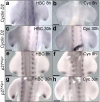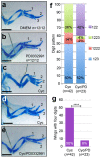An autoregulatory cell cycle timer integrates growth and specification in chick wing digit development
- PMID: 31545166
- PMCID: PMC6777937
- DOI: 10.7554/eLife.47625
An autoregulatory cell cycle timer integrates growth and specification in chick wing digit development
Abstract
A fundamental question is how proliferation and growth are timed during embryogenesis. Although it has been suggested that the cell cycle could be a timer, the underlying mechanisms remain elusive. Here we describe a cell cycle timer that operates in Sonic hedgehog (Shh)-expressing polarising region cells of the chick wing bud. Our data are consistent with Shh signalling stimulating polarising region cell proliferation via Cyclin D2, and then inhibiting proliferation via a Bmp2-p27kip1 pathway. When Shh signalling is blocked, polarising region cells over-proliferate and form an additional digit, which can be prevented by applying Bmp2 or by inhibiting D cyclin activity. In addition, Bmp2 also restores posterior digit identity in the absence of Shh signalling, thus indicating that it specifies antero-posterior (thumb to little finger) positional values. Our results reveal how an autoregulatory cell cycle timer integrates growth and specification and are widely applicable to many tissues.
Keywords: Shh; chicken; developmental biology; digits; growth; limb; patterning; timing.
© 2019, Pickering et al.
Conflict of interest statement
JP, KC, MT No competing interests declared
Figures








Similar articles
-
A model for anteroposterior patterning of the vertebrate limb based on sequential long- and short-range Shh signalling and Bmp signalling.Development. 2000 Apr;127(7):1337-48. doi: 10.1242/dev.127.7.1337. Development. 2000. PMID: 10704381
-
Inhibition of Shh signalling in the chick wing gives insights into digit patterning and evolution.Development. 2016 Oct 1;143(19):3514-3521. doi: 10.1242/dev.137398. Development. 2016. PMID: 27702785 Free PMC article.
-
Integration of growth and specification in chick wing digit-patterning.Nature. 2008 Apr 17;452(7189):882-6. doi: 10.1038/nature06718. Epub 2008 Mar 19. Nature. 2008. PMID: 18354396
-
How the embryo makes a limb: determination, polarity and identity.J Anat. 2015 Oct;227(4):418-30. doi: 10.1111/joa.12361. Epub 2015 Aug 7. J Anat. 2015. PMID: 26249743 Free PMC article. Review.
-
Evolution of antero-posterior patterning of the limb: Insights from the chick.Genesis. 2018 Jan;56(1):e23047. doi: 10.1002/dvg.23047. Epub 2017 Jul 22. Genesis. 2018. PMID: 28734068 Free PMC article. Review.
Cited by
-
Sonic hedgehog is not a limb morphogen but acts as a trigger to specify all digits in mice.Dev Cell. 2022 Sep 12;57(17):2048-2062.e4. doi: 10.1016/j.devcel.2022.07.016. Epub 2022 Aug 16. Dev Cell. 2022. PMID: 35977544 Free PMC article.
-
Fgf signalling triggers an intrinsic mesodermal timer that determines the duration of limb patterning.Nat Commun. 2023 Sep 20;14(1):5841. doi: 10.1038/s41467-023-41457-6. Nat Commun. 2023. PMID: 37730682 Free PMC article.
-
Genetic basis for an evolutionary shift from ancestral preaxial to postaxial limb polarity in non-urodele vertebrates.Curr Biol. 2021 Nov 22;31(22):4923-4934.e5. doi: 10.1016/j.cub.2021.09.010. Epub 2021 Oct 4. Curr Biol. 2021. PMID: 34610275 Free PMC article.
-
Retinoic acid influences the timing and scaling of avian wing development.Cell Rep. 2022 Jan 25;38(4):110288. doi: 10.1016/j.celrep.2021.110288. Cell Rep. 2022. PMID: 35081337 Free PMC article.
-
Of mitogens and morphogens: modelling Sonic Hedgehog mechanisms in vertebrate development.Philos Trans R Soc Lond B Biol Sci. 2020 Oct 12;375(1809):20190660. doi: 10.1098/rstb.2019.0660. Epub 2020 Aug 24. Philos Trans R Soc Lond B Biol Sci. 2020. PMID: 32829689 Free PMC article. Review.
References
-
- Barres BA, Lazar MA, Raff MC. A novel role for Thyroid-Hormone, glucocorticoids and retinoic acid in timing oligodendrocyte development. Development. 1994;120:1097–1108. - PubMed
Publication types
MeSH terms
Substances
Grants and funding
LinkOut - more resources
Full Text Sources
Miscellaneous

